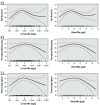Manganese Exposure and Neurocognitive Outcomes in Rural School-Age Children: The Communities Actively Researching Exposure Study (Ohio, USA)
- PMID: 25902278
- PMCID: PMC4590758
- DOI: 10.1289/ehp.1408993
Manganese Exposure and Neurocognitive Outcomes in Rural School-Age Children: The Communities Actively Researching Exposure Study (Ohio, USA)
Abstract
Background: Manganese (Mn) plays a vital role in brain growth and development, yet excessive exposure can result in neurotoxicity. Marietta, Ohio, is home to the nation's longest-operating ferromanganese refinery, and community concern about exposure led to the development of the research study.
Objectives: Our overall goal was to address the community's primary research question: "Does Mn affect cognitive development of children?" We evaluated the relationships between Mn exposure as measured by blood and hair Mn, along with other neurotoxicants including blood lead (Pb) and serum cotinine, and child cognition.
Methods: Children 7-9 years of age were enrolled (n = 404) in the Communities Actively Researching Exposure Study (CARES) from Marietta and Cambridge, Ohio, and their surrounding communities from October 2008 through March 2013. Blood and hair were analyzed for Mn and Pb, and serum was analyzed for cotinine. We used penalized splines to assess potential nonlinear associations between biological measures and IQ subscale scores, followed by multivariable regression models with categorical variables based on quartiles of the distribution for biological measures with nonlinear associations and continuous variables for biological measures with linear associations.
Results: Geometric mean blood (n = 327) and hair Mn (n = 370) concentrations were 9.67 ± 1.27 μg/L and 416.51 ± 2.44 ng/g, respectively. After adjusting for potential confounders, both low and high blood and hair Mn concentrations were associated with lower Full Scale IQ and subscale scores, with significant negative associations between the highest quartile and middle two quartiles of blood Mn (β -3.51; 95% CI: -6.64, -0.38) and hair Mn (β -3.66; 95% CI: -6.9, -0.43%) and Full Scale IQ.
Conclusions: Both low and high Mn concentrations in blood and hair were negatively associated with child IQ scores. Serum cotinine was negatively associated with child cognitive function.
Conflict of interest statement
C.B. is a member of Neighbors for Clean Air. All other authors declare they have no actual or potential competing financial interests.
Figures

References
-
- Aschner M. Manganese homeostasis in the CNS. Environ Res. 1999;80(2 pt 1):105–109. - PubMed
-
- Aschner M. The transport of manganese across the blood-brain barrier. Neurotoxicology. 2006;27:311–314. - PubMed
-
- ATSDR (Agency for Toxic Substances and Disease Registry). Toxicological Profile for Manganese. 2000. Available: http://www.atsdr.cdc.gov/ToxProfiles/TP.asp?id=102&tid=23 [accessed 6 April 2015] - PubMed
Publication types
MeSH terms
Substances
Grants and funding
LinkOut - more resources
Full Text Sources
Other Literature Sources

